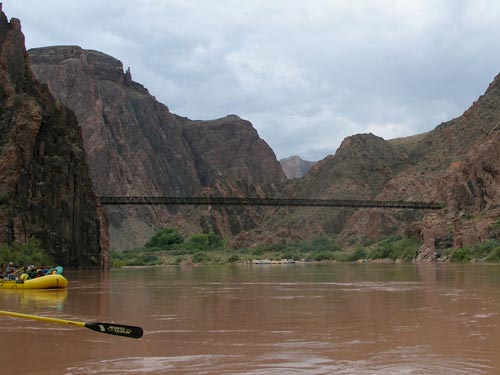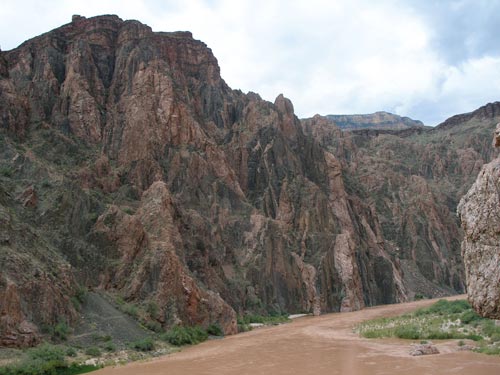- Cremation (mile 87) to Granite (mile 93) - stop at Phantom Ranch
Again... up at 5 am. It was muggy and overcast. Bats, birds and cicadas made their presence known.

A morning view of Cremation Camp from the tent

A groover (or latrine) with a view
A park rule states that all human waste must be carried out (not buried). A groover is basically a tightly-locking rocket box with a 'comfy' seat on it. Its name comes from a time when there were no seats and the metal box left a distinctive groove in your hindquarters. Originally, setting it up and taking it down was one of the rotational chores, but Janet offered to do it full-time in trade for getting out of cooking and other tasks. Done!!
Today is a big day, with several big rapids on the agenda: Horn, Hermit and Granite. But our first stop was just a few minutes away at Phantom Ranch.
Phantom Ranch is a tiny resort village at the bottom of the canyon where one can get supplies, send mail and in general feel connected to the world again. The site was originally used by Native Americans from as far back as 1050. Prospectors began using the area in the 1890s to haul ore on burros (or small donkeys). In the early 1900's, the trail up to the canyon's North Rim was improved to support tourism. It was visited by President Theodore Roosevelt in 1913 who made the Grand Canyon a National Park in 1919.

Approaching the boat beach and Black or Kaibab Bridge (a suspension bridge built in 1928) at mile 87.5

The mule is the canyon's beast of burden. A mule is the infertile offspring of a male donkey and a female horse. Mules seem to exhibit the best qualities of their parents: the patience, endurance and sure-footedness of the donkey, and the strength and courage of the horse.

A Rock Squirrel feeds on the fruit of a Prickly Pear. This is the largest ground squirrel in the southwestern United States. It digs burrows under large rocks, trees and bushes. Its diet ranges from grains, berries and roots to grasshoppers, earthworms and even young wild turkeys.

Silverleaf Nightshade is a member of the Solanaceae family (the nightshade or potato family). Its leaves and fruit are toxic at all stages of maturity.
I went into town with the others and sent my obligatory postcard letting folks know I had survived at least this far. Originally the plan was for just a quick 20-minute stop, but some people wanted to stay longer and enjoy the finer things of life... air-conditioning, ice-cream, etc. So I headed out to do a short hike and see the local area.
I did a loop, starting with the River Trail which crossed over Silver Bridge and continued along the cliff path (which smelled like mules) along the southside of the Colorado River. It then connected with the South Kaibab Trail which crossed back over the river via Black Bridge. It was lovely... but very humid.

The incredibly clear Bright Angel Creek was named by Major John Wesley Powell in 1869 to counteract a muddy tributary upstream named Dirty Devil.

Silver Bridge carries a transcanyon water pipeline beneath it. Although the Colorado River is the source of water for seven states, it is not the direct source of water for Grand Canyon National Park. The pipeline (completed in 1970) brings water from Roaring Springs (below the North Rim) to a pumping station on the other side.

The river rushes below.

A view downstream from the bridge

Looking upstream, one can get a glimpse of Black Bridge and the boat beach.

Bright Angel Creek joins the murky Colorado.

The trail wraps around the side of the cliff.... fortunately in the shade!

The Sacred Datura is a poisonous plant in the Solanaceae family used in sacred ceremonies and rites of passage by various tribes. Not everybody survives.

The trail joins the South Kaibab Trail (below). The tunnel leads onto Black Bridge.

Crossing Black Bridge back to the north side of the river

The cliff I had just walked along

This way to the boat beach
return • continue

